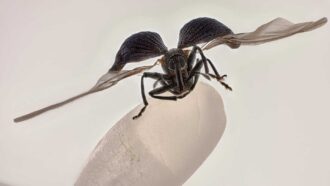acoustic: Having to do with sound or hearing.
amphibians: A group of animals that includes frogs, salamanders and caecilians. Amphibians have backbones and can breathe through their skin. Unlike reptiles, birds and mammals, unborn or unhatched amphibians do not develop in a special protective sac called an amniotic sac.
disk: A round, flat and usually fairly thin object.
ecological: An adjective that refers to a branch of biology that deals with the relations of organisms to one another and to their physical surroundings. A scientist who works in this field is called an ecologist.
family: A taxonomic group consisting of at least one genus of organisms. A genus is a group of species such as Homo sapiens (your species).
fiction: (adj. fictional) An idea or a story that is made-up, not a depiction of real events.
herpetologist: A scientist who works on the biology of reptiles and amphibians.
larynx: The hollow, muscular organ forming an air passage to the lungs and holding the vocal cords in humans and many other animals including birds. It’s also known as the voice box.
range: The full extent or distribution of something. For instance, a plant or animal’s range is the area over which it naturally exists. (in math or for measurements) The extent to which values can vary (such as the highest to lowest temperatures). Also, the distance within which something can be reached or perceived.
reptile: Vertebrate animals belonging to a group known as Reptilia. Most reptiles have skin that is covered with scales or horny plates. Snakes, turtles, lizards and alligators are all reptiles. Once considered their own separate group, birds now belong to this order. With the exception of modern birds, most reptiles are cold-blooded (or ectothermic).
risk: The chance or mathematical likelihood that some bad thing might happen. For instance, exposure to radiation poses a risk of cancer. Or the hazard — or peril — itself. (For instance: Among cancer risks that the people faced were radiation and drinking water tainted with arsenic.)
species: A group of similar organisms capable of producing offspring that can survive and reproduce.
survey: To view, examine, measure or evaluate something, often land or broad aspects of a landscape.









